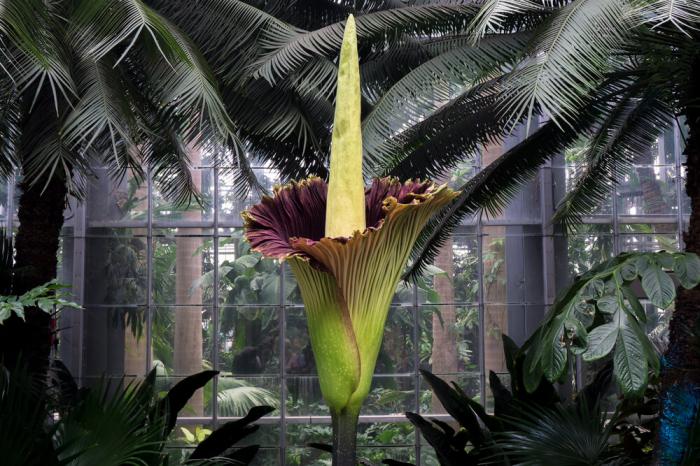
The corpse flower is one of the largest, stinkiest, and shortest-lived blossoms among the world’s plants, and one is about to bloom at Longwood Gardens in Kennett Square, Pennsylvania.
The Longwood Gardens corpse flower has been named Sprout by the garden’s staff. Corpse flowers like Sprout only bloom once every 7-10 years.
When Sprout bloomed set forth its 6-foot-tall, stinky, bright green, and deep red flower on July 13, it only lasted 24-48 hours before withering away. Because of that, Longwood extended its hours on July 13 through 14.
Unfortunately, when the event occurred, Longwood was under a COVID-constrained plan restricting attendance to Sprout’s blooming with timed ticketing.
Usually, when a corpse flower blooms in a botanical garden, the event is cheered by crowds eager to experience the rare event and horrible smell.
About the Corpse Flower
The corpse flower is native to the Indonesian island of Sumatra and western Java.
Also known by its scientific name, titan annum, the unusual plant was first described in 1878 by an Italian, botanist Odoardo Beccari.
Its smell is like that of rotting meat. The stench attracts flesh flies and carrion-eating beetles that pollinate it. Furthermore, the flower’s texture, and deep red color and texture add to the illusion that the flower is a rotting piece of meat. Finally, the tip of the flower is close to a human body temperature, which helps the stench spread. It’s believed the “body heat” also adds to the illusion of dying flesh, attracting carcass-eating insects.
After the stinky flower blooms and dies back, a giant leaf, sometimes 20 feet tall and 16 feet wide, will grow. The leaf grows on a stalk that branches off into three sections at the top; each of these sprouts many smaller leaflets.
The corpse flower was introduced to Europe and then to the United States. It first flowered outside of Sumatra in London, at the Royal Botanical Gardens in 1889. The first corpse flower blossom in the U.S. was in 1937 at the New York Botanical Garden.
Pittsburgh’s Phipps Conservatory and Botanical Gardens had two corpse flowers, named Romero and Barbara. Romero bloomed in 2016 and Barbara bloomed in 2017.
The Pittsburg plants were named for the late George Romero, a local filmmaker who pioneered the modern zombie genre. Barbara was one of the main characters in Romero’s classic, “Night of the Living Dead.” The names are very appropriate for flowers that smell like a rotting zombie.
About Sprout, the Longwood Corpse Flower
Longwood’s corpse flower began its life in 2008, growing from seed at the University of California Berkley. Thus, it was named Sprout.
Sprout was transferred to the Chicago Botanic Garden, where it bloomed in 2016, then the unusual plant was given to Longwood Gardens by the Chicago Botanic Garden in 2018. After being repotted in March of 2020, Sprout began to show new growth in May and was placed back on public display.
These unusual plants cycle through periods of dormancy and growth. When Sprout arrived at Longwood Gardens in Kennett Square, Pennsylvania, it had recently awakened from its dormancy, growing a leaf stalk that would eventually reach a height of 10 feet. Sprout was on display as a 10-foot-tall leaf for around a year until it began another dormancy in October 2019.
Sprout spent the cold, Pennsylvania winter in the Longwood’s back greenhouse, in a comfortable temperature of around 70 degrees. The soil was kept moist, but not too moist. The Longwood’s horticulturists were amazed and delighted when a flower bud unexpectedly began to form in mid-May 2020.
If you can’t visit Longwood Gardens during Sprout’s one-day bloom, Longwood has set up a live stream on the YouTube channel of its corpse flower.









